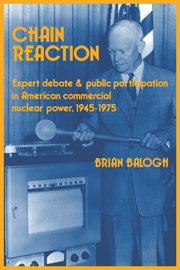 Chain Reaction
Chain Reaction Book contents
- Frontmatter
- Contents
- Acknowledgments
- List of abbreviations
- 1 From fission to fusion: professionalization and politics in twentieth-century America
- 2 The promise of the proministrative state: nuclear experts and national politics, 1945–1947
- 3 Forging an iron triangle: the politics of verisimilitude
- 4 Triangulating demand: the Atomic Energy Commission's first decade of commercialization
- 5 The centrifugal push of expertise: reactor safety, 1947–1960
- 6 The magnetic pull of professional disciplines, issue networks, and local government
- 7 Nuclear experts on top, not on tap: mainstreaming expertise, 1957–1970
- 8 Nuclear experts everywhere: the challenge to nuclear power, 1960–1975
- 9 Conclusion: harnessing political chain reactions
- Index
9 - Conclusion: harnessing political chain reactions
Published online by Cambridge University Press: 07 May 2010
- Frontmatter
- Contents
- Acknowledgments
- List of abbreviations
- 1 From fission to fusion: professionalization and politics in twentieth-century America
- 2 The promise of the proministrative state: nuclear experts and national politics, 1945–1947
- 3 Forging an iron triangle: the politics of verisimilitude
- 4 Triangulating demand: the Atomic Energy Commission's first decade of commercialization
- 5 The centrifugal push of expertise: reactor safety, 1947–1960
- 6 The magnetic pull of professional disciplines, issue networks, and local government
- 7 Nuclear experts on top, not on tap: mainstreaming expertise, 1957–1970
- 8 Nuclear experts everywhere: the challenge to nuclear power, 1960–1975
- 9 Conclusion: harnessing political chain reactions
- Index
Summary
The powerful chain reaction triggered by unprecedented reliance on expert guidance housed in large-scale bureaucratic structures funded at public expense is perhaps the most significant political development in America in the past fifty years. Plotting the course of this chain reaction revises our understanding of the rise and fall of commercial nuclear power in the United States. It redirects the emphasis away from external pressures, whether World War II or growing environmental consciousness, toward the professionals and administrators who staked proprietary claims to this new federal policy. Nuclear power's trajectory, I argue, is best explained by an internal dynamic fueled by the constantly shifting elaboration of expertise and administrative capacity within the nuclear community and the juxtaposition of the proministrative state and an older, less professional, and far more decentralized American political landscape. This perspective in turn shifts the chronological focus of my study away from the more dramatic beginning or demise of nuclear power to the crucial years between 1945 and 1975. That story, and the techniques I have used to construct it, however, have broader implications.
For historians, my approach provides a methodology and narrative form that capture the high degree of contingency and political choice embedded in what more commonly have been presented as the overly determined and numbing forces of professionalization, bureaucratization, science and technology. My account repoliticizes large segments of social and public activities often abandoned to the supposedly predictable forces of modernization.
- Type
- Chapter
- Information
- Chain ReactionExpert Debate and Public Participation in American Commercial Nuclear Power 1945–1975, pp. 302 - 326Publisher: Cambridge University PressPrint publication year: 1991


